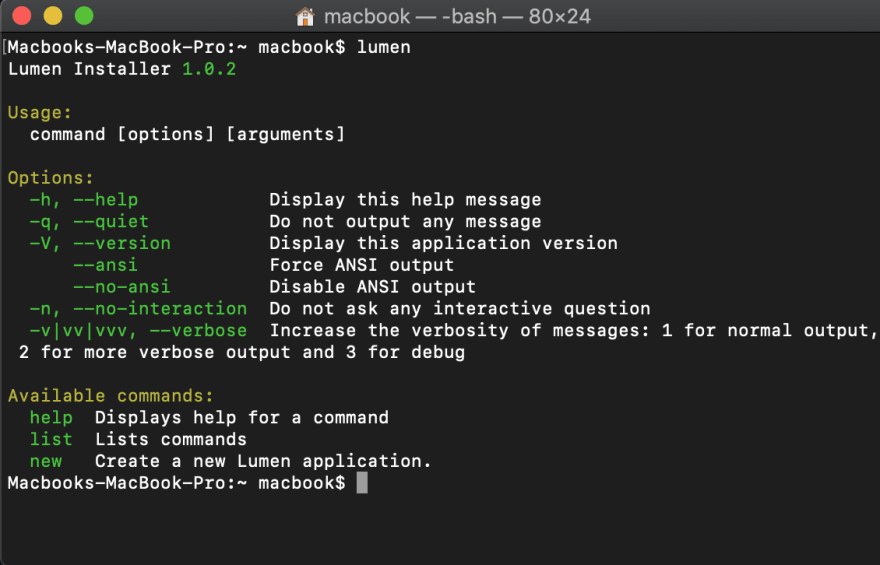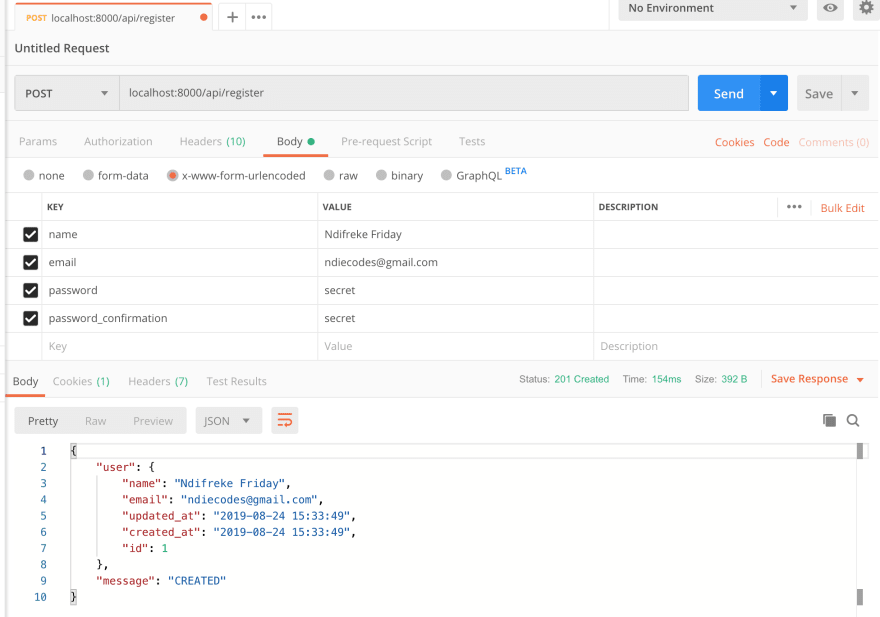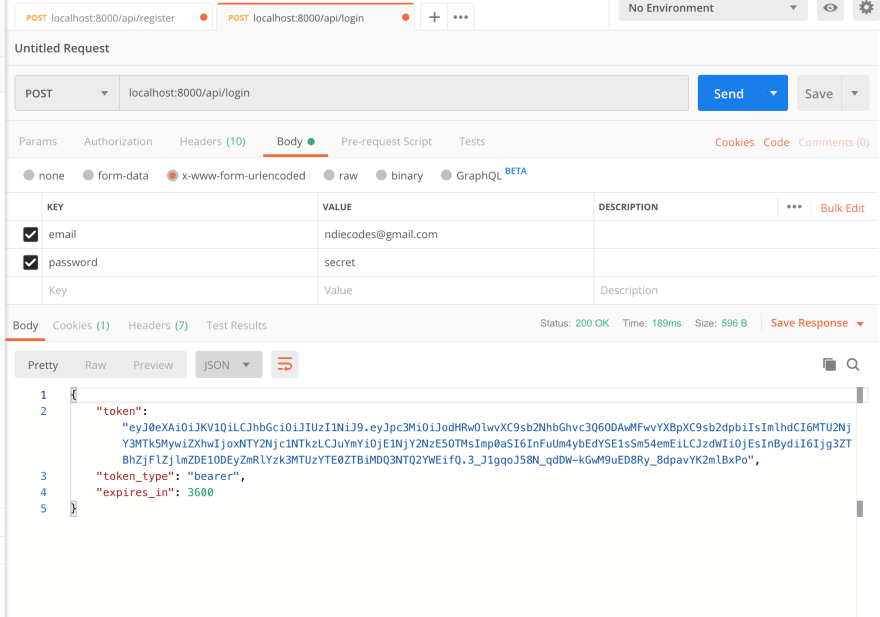In this tutorial, we will be using lumen; a super-fast micro-framework by laravel to build a simple and secure REST API. At the end of this tutorial, you should be able to build production-ready APIs. Let's get started!
Prerequisite
Make sure you have the essentials, I beg of you.
- PHP >= 7.1.3
- OpenSSL PHP Extension
- PDO PHP Extension
- Mbstring PHP Extension
- Mysql >= 5.7
- Composer (Dependency Manager for PHP)
- Postman (To test your endpoints)
Installation
First things first, you need to get lumen's cli.
$ composer global require "laravel/lumen-installer"
If your download was successful, run below command to confirm you have lumen installed.
$ lumen
If you encounter an error like -bash: lumen: command not found, you need to add composer's vender bin to your path.
If all is in order, you should see something like so.
Now run this command to create the lumen project
$ lumen new auth-app
Enter the project folder
$ cd auth-app
Run the app
$ php -S localhost:8000 -t public
Load localhost:8000 on your browsers address bar and it should render a result as shown below.
Open up the project (auth-app) in your preferred editor.
Create a .env file, copy all contents in .env.example into the .env file and add your database configurations.
In boostrap/app.php uncomment the facades and eloquent method
//before
// $app->withFacades();
// $app->withEloquent();
//after
$app->withFacades();
$app->withEloquent();
Turning on withFacades inject the application IoC to Illuminate\Support\Facades\Facade. Without doing so even if you're importing Illuminate\Support\Facades\File it wouldn't work. Credit
The $app->withEloquent() method actually enables the query builder too. It's registering the DatabaseServiceProvider, which is required to use the query builder. Credit.
Create a user
Make user's database migration
$ php artisan make:migration create_users_table --create=users
Locate the migration file database/migrations/*_create_users_table.php and add neede table columns(name, email, password); see code below:
...
public function up()
{
Schema::create('users', function (Blueprint $table) {
$table->bigIncrements('id');
$table->string('name');
$table->string('email')->unique()->notNullable();
$table->string('password');
$table->timestamps();
});
}
...
Migrate your database
$ php artisan migrate
Add register route which as the name implies; register users. Locate routes/web.php and insert the needed code as seen below
// API route group
$router->group(['prefix' => 'api'], function () use ($router) {
// Matches "/api/register
$router->post('register', 'AuthController@register');
});
Since we are going to prefix api in all our endpoint, to reduce repetition we will use route grouping to do just that.
This method ($router->post($uri, $callback); takes in a $url and a $callback parameter. In the $callback, AuthController is our controller class (we will create this class in a bit) and register is a method in said class.
Let's create our AuthControler.
Create file app/Http/Controllers/AuthController.php and populate it with code as seen below.
<?php
namespace App\Http\Controllers;
use Illuminate\Http\Request;
use App\User;
class AuthController extends Controller
{
/**
* Store a new user.
*
* @param Request $request
* @return Response
*/
public function register(Request $request)
{
//validate incoming request
$this->validate($request, [
'name' => 'required|string',
'email' => 'required|email|unique:users',
'password' => 'required|confirmed',
]);
try {
$user = new User;
$user->name = $request->input('name');
$user->email = $request->input('email');
$plainPassword = $request->input('password');
$user->password = app('hash')->make($plainPassword);
$user->save();
//return successful response
return response()->json(['user' => $user, 'message' => 'CREATED'], 201);
} catch (\Exception $e) {
//return error message
return response()->json(['message' => 'User Registration Failed!'], 409);
}
}
}
Register a user(use POSTMAN) with route localhost:8000/api/register and you should get a successful response like so
User sign in
Pull in the JWT authentication package.
$ composer require tymon/jwt-auth:dev-develop
Generate your API secret
$ php artisan jwt:secret
create file config/auth.php with below config
//config.auth.php
<?php
return [
'defaults' => [
'guard' => 'api',
'passwords' => 'users',
],
'guards' => [
'api' => [
'driver' => 'jwt',
'provider' => 'users',
],
],
'providers' => [
'users' => [
'driver' => 'eloquent',
'model' => \App\User::class
]
]
];
Make some changes to your User model(app/User.php) to fit tymon/jwt-auth's requirements. Keep your eye out for everything that includes "JWT".
<?php
namespace App;
use Illuminate\Auth\Authenticatable;
use Laravel\Lumen\Auth\Authorizable;
use Illuminate\Database\Eloquent\Model;
use Illuminate\Contracts\Auth\Authenticatable as AuthenticatableContract;
use Illuminate\Contracts\Auth\Access\Authorizable as AuthorizableContract;
use Tymon\JWTAuth\Contracts\JWTSubject;
class User extends Model implements AuthenticatableContract, AuthorizableContract, JWTSubject
{
use Authenticatable, Authorizable;
/**
* The attributes that are mass assignable.
*
* @var array
*/
protected $fillable = [
'name', 'email'
];
/**
* The attributes excluded from the model's JSON form.
*
* @var array
*/
protected $hidden = [
'password',
];
/**
* Get the identifier that will be stored in the subject claim of the JWT.
*
* @return mixed
*/
public function getJWTIdentifier()
{
return $this->getKey();
}
/**
* Return a key value array, containing any custom claims to be added to the JWT.
*
* @return array
*/
public function getJWTCustomClaims()
{
return [];
}
}
Make some changes to bootstrap/app.php
//before
// $app->routeMiddleware([
// 'auth' => App\Http\Middleware\Authenticate::class,
// ]);
//After
$app->routeMiddleware([
'auth' => App\Http\Middleware\Authenticate::class,
]);
//before
// $app->register(App\Providers\AppServiceProvider::class);
// $app->register(App\Providers\AuthServiceProvider::class);
// $app->register(App\Providers\EventServiceProvider::class);
//After
// $app->register(App\Providers\AppServiceProvider::class);
$app->register(App\Providers\AuthServiceProvider::class);
// $app->register(App\Providers\EventServiceProvider::class);
// Add this line
$app->register(Tymon\JWTAuth\Providers\LumenServiceProvider::class);
Add login route in routes/web.php
// API route group
$router->group(['prefix' => 'api'], function () use ($router) {
// Matches "/api/register
$router->post('register', 'AuthController@register');
// Matches "/api/login
$router->post('login', 'AuthController@login');
});
Add a global respondWithToken method to Controller class in app/Http/Controllers/Controller.php. This is so we could access it from any other controller.
...
//import auth facades
use Illuminate\Support\Facades\Auth;
//Add this method to the Controller class
protected function respondWithToken($token)
{
return response()->json([
'token' => $token,
'token_type' => 'bearer',
'expires_in' => Auth::factory()->getTTL() * 60
], 200);
}
Add a login method to your AuthController class in app/Http/Controllers/AuthController.php
...
//import auth facades
use Illuminate\Support\Facades\Auth;
...
/**
* Get a JWT via given credentials.
*
* @param Request $request
* @return Response
*/
public function login(Request $request)
{
//validate incoming request
$this->validate($request, [
'email' => 'required|string',
'password' => 'required|string',
]);
$credentials = $request->only(['email', 'password']);
if (! $token = Auth::attempt($credentials)) {
return response()->json(['message' => 'Unauthorized'], 401);
}
return $this->respondWithToken($token);
}
Login a user using route localhost:8000/api/login and you should get a successful response like so:
Authenticated routes
For our grand finale, we are going to make some authenticated routes.
Add a couple of routes to routes/web.php
...
// API route group
$router->group(['prefix' => 'api'], function () use ($router) {
// Matches "/api/register
$router->post('register', 'AuthController@register');
// Matches "/api/login
$router->post('login', 'AuthController@login');
// Matches "/api/profile
$router->get('profile', 'UserController@profile');
// Matches "/api/users/1
//get one user by id
$router->get('users/{id}', 'UserController@singleUser');
// Matches "/api/users
$router->get('users', 'UserController@allUsers');
});
...
Create a file app/Http/Controllers/UserController.php and populate it with this elegant looking code.
<?php
namespace App\Http\Controllers;
use Illuminate\Support\Facades\Auth;
use App\User;
class UserController extends Controller
{
/**
* Instantiate a new UserController instance.
*
* @return void
*/
public function __construct()
{
$this->middleware('auth');
}
/**
* Get the authenticated User.
*
* @return Response
*/
public function profile()
{
return response()->json(['user' => Auth::user()], 200);
}
/**
* Get all User.
*
* @return Response
*/
public function allUsers()
{
return response()->json(['users' => User::all()], 200);
}
/**
* Get one user.
*
* @return Response
*/
public function singleUser($id)
{
try {
$user = User::findOrFail($id);
return response()->json(['user' => $user], 200);
} catch (\Exception $e) {
return response()->json(['message' => 'user not found!'], 404);
}
}
}
Below is an example call to one of the three newly added endpoints
Here's a link to the full code on github.
The end-ish!
I hope this article has helped you in some way, and that you build upon this knowledge to deploy awesome APIs in the nearest future. I would like to see your contributions down in the comments too.
Hasta la vista.











Latest comments (51)
This has been an amazing tutorial , few bugs but were resolved :)-
thanks for sharing this great tutorial.
I had issue with ('model' => \App\User::class).
so I changed it to ('model' => \App\Models\User::class),
and it works now.
Thanks for the tutorial, helps me a lot
Great post! You had save me!
how to do this when using mongodb?
Wonderful Bro.. It really helped me to understand the concept.. Thank you..
Hi,
Thanks for your great tutorial.
But I want a custom field (email and password) both so could you make it an example for that.
My field name = USER_NAME, PASSWORD (Both are capital)
I try but token always false.
If you do then its great help for me.
Thank you
This was of great help. The only problem I encountered was when running
php artisan jwt:secret.$app->register(Tymon\JWTAuth\Providers\LumenServiceProvider::class);needs to be added to app.php before the command is executed.This was really helpful, man! Thanks very much.
Does the lumen version affect? I use lumen version 6
Hy bro, thanks for the tutorial. I want to know how I implements logout
public function logout () {
Auth::logout();
return response()->json(['message' => 'Successfully logged out']);
}
can you go further this post by making role-based auth in lumen?
What a great tutorial. Thank you very much!
You are welcome
Please, can you explain how to reset the password of user?
Maybe this can help
stackoverflow.com/questions/373380...
Thank you, very good tutorial